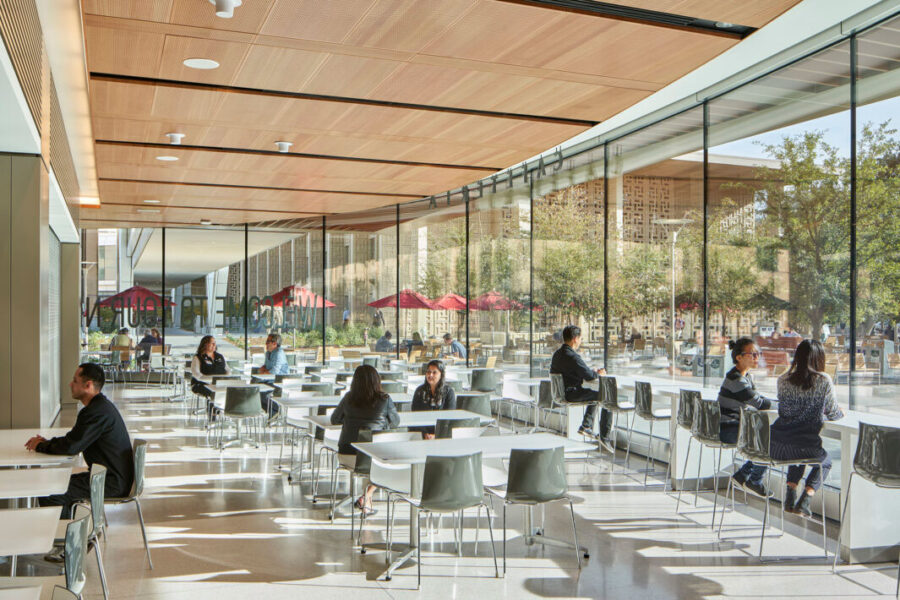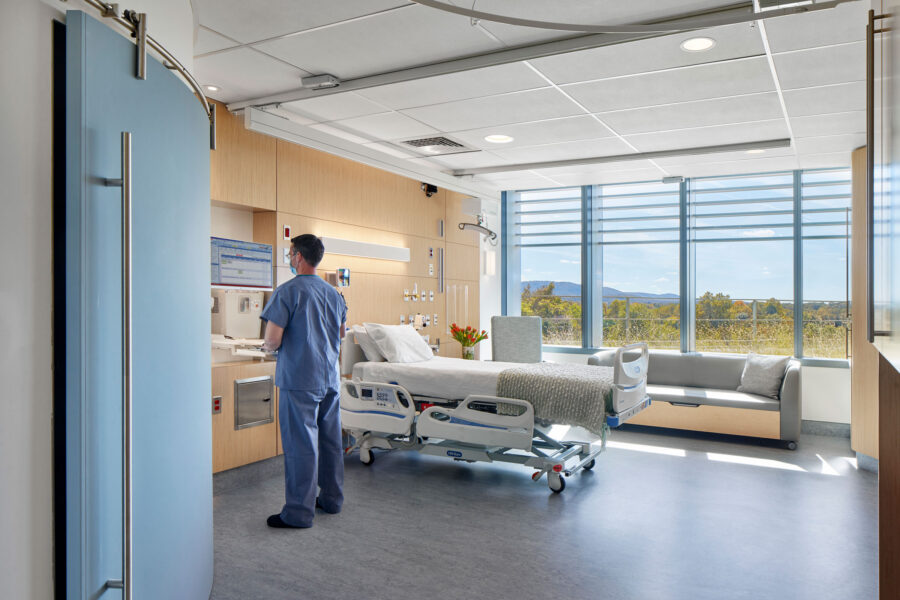Story at a glance:
- Stanford is known for its forward-thinking, patient-centric places.
- Vibrant, healthy health care spaces today often include colorful wall coverings.
- Durable doors are another way to improve energy efficiency in health care spaces.
Access to natural light and nature views, custom imagery on walls, chairs that are easy to clean, and doors that are durable—some of the features in modern health care design are expected, while some are increasingly in demand.
For years Stanford Health Care has been moving the needle in health care design, developing patient-centric spaces with features like light-filled lobbies and garden patios, plus special attention to material choices. “Stanford has always been a very responsible designer when it comes to designing buildings that meet our academic needs and the needs of patients,” says Helen Wilmot, chief facilities and sustainability officer for Stanford Health Care.
Stanford is continually looking at what sustainability means for a building—from the materials in its spaces to the health care system’s design guidelines to what happens decades after a building is built. “How is the mechanical, electrical, and plumbing designed such that over the life of the building it’s very aware of greenhouse gas emissions, energy consumption, water usage, natural gas usage?” she says. “How can the design of a building address that in a much more prescriptive way than before?”
Flexible Design

Stanford Hospital at 500 Pasteur Drive. Photo courtesy of Stanford
Stanford focuses in part on the finishes, materials, and interior furnishings in spaces, as all affect patient and staff experience, says Rachel DeGuzman, vice president of facilities planning design and construction at Stanford. Stanford’s space designs are meant to be flexible, with minimal construction waste. Block E, a nine-story, all-electric medical office building being designed in Redwood City, emphasizes flexibility.
“Covid brought to light the need for adaptable spaces for emergency needs, so we’re looking at modular systems—having the core shell be traditional construction but looking at building each floor with clinical pods in a modular way, not only with walls but also with a vacuum plumbing system. That allows for a big reduction in water usage,” DeGuzman says. “The modularity of those clinic pods will allow us to reconfigure space in a short time frame.” It also reduces construction waste, as the components are easily interchangeable an interchangeable kit of parts.
Color & Texture

A children’s area in a hospital in Texas is brought to life in part with Acrovyn Wall Panels woodgrain product. Photo courtesy of Construction Specialties
Another way to easily improve health care spaces is with consideration of color. Most health care spaces are a lot livelier and more comfortable than the spaces of old, and things like custom imagery on walls and biophilic design elements are growing in popularity. Wall coverings and wall protection in particular have grown leaps and bounds over the past decade, says Amy Sweeting, product manager at Construction Specialties (CS), which specializes in manufacturing and selling specialty architectural products all over the world.
“You’re not just looking at a white or a sterile gray corner guard; there’s a variety of beautiful options that blend seamlessly into the environment while protecting the space. There are on-trend woodgrains, custom images, and even real textiles that are fused into our Acrovyn® wall covering—all of which are bacterial resistant,” Sweeting says.
Acrovyn Wall Covering + Panels collection of finishes includes PVC-free Acrovyn solid colors, woodgrains and brushed metals, and Acrovyn by Design® embedded digital imagery (think nature scenes and biophilic design), giving designers even more freedom. Acrovyn is more durable than laminate and stained wood, too. More health care designers are incorporating solutions like Acrovyn wall coverings to protect walls and also offer cheerful decor or act as wayfinding.
“A lot of healing spaces and medical spaces are shifting their focus to provide a positive human experience,” Sweeting says. “Health care designers are creating environments that lessen the anxiety that people have sitting inside waiting rooms and lobby areas and instead promote positivity about going to the doctor or waiting for a loved one.”
Wall coverings also protect high-traffic areas like in emergency departments. CS puts a lot of effort into choosing the right materials to have the right texture for its wall protection products, especially as wall coverings and doors can get really beat up over time. “We put a lot of focus on what that texture is,” Sweeting says.
Suede is Acrovyn’s standard texture for wall covering finish options. “Because it’s wall protection and there is a lot of impact along the surface of the wall, you need to have enough texture to minimize the appearance of scratches without having so much that you can’t easily clean the sheet. Our Suede is a perfect balance of hiding any scuffs and not harboring dirt or bacteria.”
In patient rooms and flex spaces CS offers the Hush Curtain, which protects patients’ privacy, not just visually but audibly as well. The Hush Curtain is designed with pockets to hold acoustical panels that provide noise absorption, perfect for open spaces that need a quick conversion to patient space.
Durable Doors

Construction Specialties’ new Acrovyn Curved Door meets hospitals’ need to save space and maintain critical patient sight lines. Photo courtesy of Construction Specialties
CS also manufactures heavy-duty doors that are built sustainably to stand the test of time. Acrovyn Doors can contribute to LEED credits and are made using optional FSC-certified wood cores.
Acrovyn Doors are available in dozens of color and pattern options, and they’re easy to clean and bacterial- and fungal-resistant. They also include recycled content and undergo VOC emission tests. Their durability, though, is among what makes them the most special, Sweeting says. “We are publishing a new white paper that talks about the longevity of a door. Our Acrovyn Door is characterized as a heavy-duty door—tested up to two million cycle slams. That means you can beat the door up, and it’s not going to show any wear and tear.”
The door has special edges designed to be curved like a car bumper. “Instead of having this sharp 90-degree corner, when you open a door or bump a gurney or a cleaning cart, it deflects that impact,” Sweeting says.
CS completed a life cycle cost analysis to show how much the average facility pays for a wood door. Initial investment for 500 doors totaled $270,000, and maintenance cost over 10 years was estimated at $195,000, not counting other operating costs. “If that starts chipping, you have to take the door down, you have to sand it, repaint it, stain it, whatever. If it’s a hollow metal door and it gets damaged, you have to replace it. If you have an Acrovyn door and it gets really banged up—I don’t think we’ve had to replace any edges so far—we have an ‘Edge of a Lifetime’ warranty.”
Sweeting says most doors and Acrovyn products in general—wall protection products, wall coverings, handrails, and so on—will outlive people’s preference for them aesthetically, and that’s a good thing. It means they’ll often last more than a decade. “Sometimes we don’t think about how long something is going to stay in a building, or how much is going to be contributed to a landfill because you’re throwing out old doors versus being able to remove components of a door.”
The newest product, the Acrovyn Curved Door, launched in May. The innovative design was born out of a hospital’s need for space savings and critical nurse-to-patient sight lines. By eliminating the extra wall space and curving the sharp corner of the patient bathroom, more space was devoted to the footprint of the patient room and the staff had clear visibility into the patient area.
Healthy Design, Healthy Patient

Photo courtesy of Stanford
Wilmot says a building can be healthy in many other ways besides being sustainable. And how a building contributes to the health and the recovery of the patient or the ability for the family to relax is all part of the mission at Stanford.
“Some of that well-being is cultivated by paint colors, furniture, and patterns—both natural and designed. It’s taking it a step further to consider the impact and the experience of the patients in a space,” DeGuzman says.
In a previous design of a Stanford neuroscience health center they learned from a patient advisory committee the true impact of things like patterns and colors. The neurological patients, for instance, were particularly sensitive to certain colors, patterns, and textures.
“We’re trying to be sensitive to what their needs are in terms of the simplicity of the space but also being able to bring in elements that contribute to healthy environments and enables conservation of resources.

